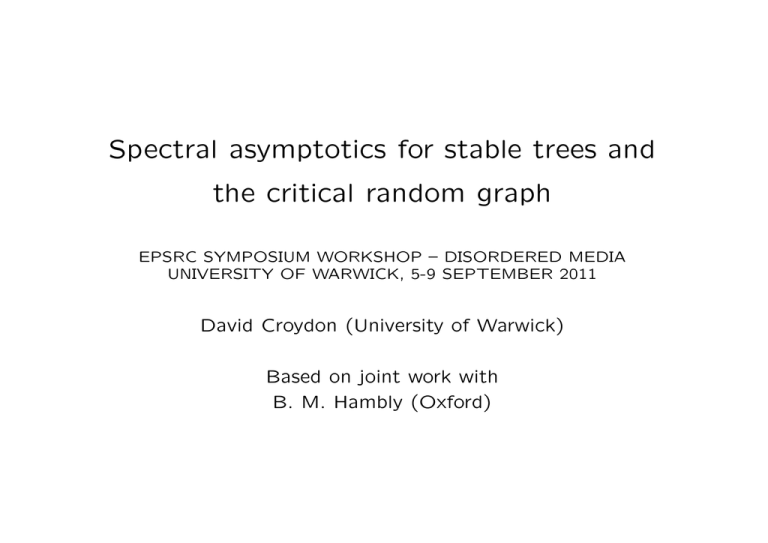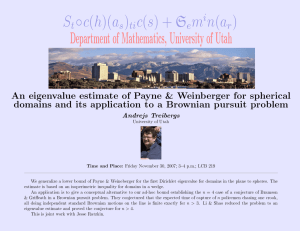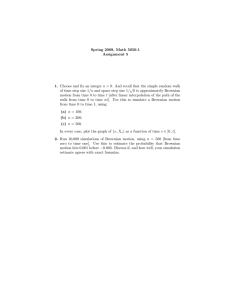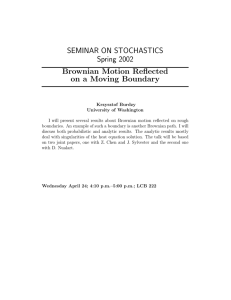Spectral asymptotics for stable trees and the critical random graph
advertisement

Spectral asymptotics for stable trees and
the critical random graph
EPSRC SYMPOSIUM WORKSHOP – DISORDERED MEDIA
UNIVERSITY OF WARWICK, 5-9 SEPTEMBER 2011
David Croydon (University of Warwick)
Based on joint work with
B. M. Hambly (Oxford)
α-STABLE TREES
α-stable trees are natural objects:
• scaling limits of conditioned Galton-Watson trees (Aldous,
Duquesne);
• can be described in terms of continuous state branching processes (Duquesne/Le Gall);
• can be constructed from Lévy processes (Duquesne/Le Gall);
• and fragmentation processes (Haas/Miermont).
Moreover, the Brownian continuum random tree (α = 2) has
connections with:
• combinatorial trees (Aldous);
• critical percolation clusters in high dimensions (Hara/Slade);
• the Erdős-Rényi random graph at criticality (Addario-Berry/
Broutin/Goldschmidt).
GALTON-WATSON TREE SCALING LIMIT
Fix α ∈ (1, 2]. Let Z be a mean 1, aperiodic, random variable
in the domain of attraction of an α-stable law, i.e. for some
an → ∞,
Z[n] − n
→ Ξ,
an
where Z[n] is the sum of n independent copies of Z, and Ξ
1
α
satisfies E(e−λΞ ) = e−λ . NB. an = n α L(n).
Let Tn be a Galton-Watson branching process with offspring
distribution Z, conditioned to have n vertices, then
n−1anTn → T (α).
BROWNIAN MOTION ON α-STABLE TREES
Let (XtTn )t≥0 be the discrete time simple random walk on Tn,
then
(α)
n−1anX T2n −1 → XtT
,
n an t
t≥0
(α)
where (XtT )t≥0 is a strong Markov diffusion on T (α) – the
Brownian motion on the α-stable tree [C.].
We will write ∆(α) for the generator of (XtT
(α)
)t≥0 (i.e.
its
semigroup is Pt = et∆(α) ), and the corresponding Dirichlet form
as:
E(α)(f, g) := −
Z
T
(α)
f ∆(α) gdµα,
where µα is the natural probability measure on T (α) that arises
as the scaling limit of uniform probability measures on GaltonWatson trees.
SPECTRUM OF ∆α
We say λ is a (Neumann) eigenvalue for E(α) if: there exists an
f ∈ F(α) such that
E(α)(f, g) = λ
Z
T
(α)
f gdµα,
∀g ∈ F(α).
Roughly speaking, −∆(α)f = λf and 0 derivative on ‘boundary’.
The eigenvalue counting function is:
n
o
N(α) (λ) := # eigenvalues of E(α) ≤ λ .
From the spectral decomposition of the transition density of
(α)
T
X
, we have
Z
T
(α)
pt (x, x)µ(α)(dx) =
(α)
(α)
and so if N(α)(λ) ≈ λγ , then pt
Z ∞
0
e−λt N(α)(dλ),
(x, x) ≈ t−γ .
PLAN
• Introduction to spectral asymptotics.
• Spectral asymptotics of self-similar fractals via renewal arguments.
• Adaptation to random fractals using branching processes.
• Consideration of α-stable trees.
• Application to critical Erdős-Rényi random graph.
CAN ONE HEAR THE SHAPE OF A DRUM?
Suppose D is a domain (with smooth boundary).
Consider the associated Dirichlet problem:
∆u + λu = 0,
u|∂D = 0.
This has discrete spectrum of eigenvalues: 0 < λ1 ≤ λ2 ≤ . . . .
If D1 and D2 have same eigenvalue sequence, must they be
congruent? (Kac 1966, Bochner, Bers. . . ).
NO!
There exist isospectral pairs of manifolds (Milnor 1964, Witt).
There also exist isospectral pairs of domains in the plane, e.g.
(Gordon/Webb/Wolpert 1992, Buser/Semmler).
So does the spectrum tell us anything about the domain?
WEYL’S FORMULA
(Weyl 1911, 1912, Ivrii 1980) For a d-dimensional compact manifold with smooth boundary, the eigenvalue counting function
N (λ) := #{n ≥ 1 : λn ≤ λ}
satisfies
1
N (λ) = cd|D|λd/2 − cd−1|∂D|d−1λ(d−1)/2 + o(λ(d−1)/2).
4
NB. cd are constants that only depend on d.
OUT OF THE CLASSICAL SETTING
Does the same result hold for (self-similar) fractal spaces?
The Sierpinski gasket, for example, has Hausdorff dimension ln 3/ ln 2, so is it the case that
N (λ) ∼ cλln 3/2 ln 2?
Does boundary appear in second order term?
How about when there is randomness in the construction?
Do we see any effect of this in the spectral
asymptotics, or is the disorder ‘averaged’ out
in a law of large numbers?
RESULTS FOR THE SIERPINSKI GASKET
Rammal/Toulouse 1983, Fukushima/Shima 1992, Kigami/Lapidus
1993, Kigami 2001,
N (λ) = λln 3/ ln 5G(ln λ) + O(1),
where G is a non-constant function with period ln 5. Note that:
1. Spectral dimension
2 ln N (λ)
ln 9
=
λ→∞
ln λ
ln 5
is not equal to Hausdorff dimension.
dS := lim
2. Weyl limit limλ→∞ λ−dS /2N (λ) does not exist.
3. Size of second order term corresponds to an intrinsic boundary of the fractal, rather than a Euclidean one.
SIERPINSKI GASKET SELF-SIMILARITY
The Sierpinski gasket K satisfies
K=
3
[
Fi(K).
i=1
F(G)
1
G
F(G)
2
F(G)
3
Moreover, the natural Dirichlet form on K satisfies:
3
5 X
E(f ◦ Fi, f ◦ Fi).
E(f, f ) =
3 i=1
SIERPINSKI GASKET SELF-SIMILARITY
The Sierpinski gasket K satisfies
K=
3
[
Fi(K).
i=1
1
5/3
1
5/3
1
1
5/3
1
1
1
1
1
Moreover, the natural Dirichlet form on K satisfies:
3
5 X
E(f ◦ Fi, f ◦ Fi).
E(f, f ) =
3 i=1
EIGENVALUE COMPARISON #1
Consider two versions of the Dirichlet problem:
ED
Ẽ
If f is an e.function of E D with e.value λ, then can check
g :=
(
f ◦ Fi−1, on Fi(K),
0
otherwise,
is a e.function of Ẽ with e.value 5λ. It follows that
3N D (λ/5) ≤ Ñ (λ) ≤ N D (λ).
EIGENVALUE COMPARISON #2
Similarly, if f is an e.function of E with e.value λ, then can check
f ◦ Fi ,
i = 1, 2, 3,
are e.functions of E with e.value λ/5. It follows that
N (λ) ≤ 3N (λ/5).
‘Dirichlet-Neumann bracketing’ says N D (λ) ≤ N (λ) ≤ N D (λ)+3,
and so
3N D (λ/5) ≤ N D (λ) ≤ 3N D (λ/5) + 9.
RENEWAL EQUATION
Write
−γt
m(t) := e
D
−γt
t
N (e ) and u(t) := e
Then
D
t
D
t
N (e ) − 3N (e /5) .
−γ ln 5m(t − ln 5)
m(t) = u(t) + 3e
Z
= u(t) +
= u(t) +
∞
Z0∞
0
m(t − s)3e−γs δln 5(ds)
m(t − s)δln 5(ds),
where we have chosen γ = ln 3/ ln 5. The renewal theorem then
implies
m(t) ∼ G(t),
where G is a ln 5-periodic function. Hence,
N (λ) ∼ N D (λ) ∼ λln 3/ ln 5G(ln λ).
RANDOM SIERPINSKI GASKET [HAMBLY]
Consider a random Sierpinski gasket:
e.g. select from
and
to build
.
We now have a statistical self-similarity for the Dirichlet form:
E(f, f ) =
M
X
1
i=1 Ri
Ei(f ◦ Fi, f ◦ Fi).
RENEWAL EQUATION IN MEAN
This translates to the e.value counting function:
M
X
NiD (λRi µi) ≤ N D (λ) ≤
i=1
NiD (λRi µi) + C.
i=1
Let m(t) := e−γt EN D (et ) and
then
M
X
u(t) := e−γt E N D (et ) −
m(t) = u(t) +
Z ∞
0
M
X
i=1
NiD (λRi µi) ,
m(t − s)e−γs ν(ds),
where ν([0, t]) = E#{i ≤ M : − ln Ri µi ≤ t}. Under a non-lattice
R
condition, if γ is chosen such that e−γs ν(ds) = 1, then
m(t) → m(∞) ∈ (0, ∞).
QUENCHED BRANCHING PROCESS
Let
X(t) := N D (et ) and η(t) := N D (et) −
M
X
NiD (λRi µi),
i=1
then
X(t) = η(t) +
M
X
Xi(t + ln Riµi).
i=1
Iterating, it is possible to write:
X(t) =
X
i∈Σ
ηi(t + ln Riµi),
the sum of a random characteristic over the elements of a continuous time branching process. It follows that
N D (λ) = λγ W + o(λγ ),
where the random variable W represents a limiting ‘mass’.
SELF-SIMILARITY OF THE BROWNIAN CRT
It is known that T = T (2) is self-similar (Aldous 1994):
- Pick 2 random points from Brownian CRT.
- Split tree at branch-point of root and these.
Results in a three copies of original tree with masses Dirichlet
1 , 1 , 1 ) distribution, and lengths scaled by square-root of these.
(2
2 2
Can apply recursively to code Brownian CRT as a random selfsimilar fractal that is almost-surely homeomorphic to a deterministic fractal [C., Hambly].
MEAN AND ALMOST-SURE FIRST ORDER
BEHAVIOUR [C., HAMBLY]
From the renewal equation, we are able to prove: for some
deterministic C ∈ (0, ∞),
EN (λ) = Cλ2/3 + O(1).
Using invariance under re-rooting, this implies:
Ept (ρ, ρ) = E
Z
T
pt(x, x)µ(dx) = C ′t−2/3 + O(1).
Moreover, from the branching process argument, we have that:
P-a.s.,
N (λ) = Cλ2/3 + o(λ2/3).
Also trace of semigroup is asymptotically smooth (cf. loglogarithmic fluctuations that occur in pt (ρ, ρ), almost surely, [C.])
SECOND ORDER BEHAVIOUR
Let Y (t) := e−2t/3X(t) − m(t). Can use a renewal equation to
show that:
et/3EY (t)2 → y(∞).
One can then use the (approximate) stochastic self-similarity,
Y (t) ≈
X
DiYi(t +
i∈Λεt
3
ln Di),
2
to prove a central limit theorem, saying that:
N(2)(λ) − Cλ2/3
λ1/3
→ N (0, y(∞)).
Conjecture: y(∞) 6= 0, which would imply second order fluctuations are of an order that is strictly bigger than the second
order of O(1) determined by the boundary (and which was seen
in the mean behaviour).
α-STABLE TREES, α ∈ (1, 2)
Spinal decomposition (Haas/Pitman/Winkel 2009):
- Choose two points at random.
- Split tree along arc between these.
Results in a countable number of copies of original tree with
masses given by a Poisson-Dirichlet distribution.
Can use this self-similarity property to deduce (C./Hambly 2010):
EN (λ) =
α
2α−1
Cλ
+O
1 +ε
2α−1
λ
.
First term also seen P-a.s. and second term in probability.
α
− 2α−1
Imply short-time heat kernel asymptotics of order t
.
CRITICAL ERDŐS-RÉNYI RANDOM GRAPH
G(N, p) is obtained via bond percolation with parameter p on
the complete graph with N vertices. We concentrate on critical
window: p = N −1 + λN −4/3. e.g. N = 100, p = 0.01:
All components have:
- size Θ(N 2/3) and surplus Θ(1) (Erdős/Rényi, Aldous),
- diameter Θ(N 1/3) (Nachmias/Peres).
CONSTRUCTION OF SCALING LIMIT FROM
BROWNIAN CRT
(Addario-Berry/Broutin/Goldschmidt) If C1N is the largest connected component of G(N, p) (in the critical window), then
N −1/3C1N → M,
for some random metric space M. Moreover, associated random
walks can be rescaled to a diffusion on M [C.].
Conditional on the number of loops, J say, and its mass, M can
be constructed by:
- choosing 3-regular graph with 3(J − 1) edges.
(Formula is slightly different if J = 0, 1.)
- placing independent Brownian CRTs along edges, with masses
1 ) distribution.
determined by a Dirichlet ( 1
,
.
.
.
,
2
2
SPECTRAL ASYMPTOTICS FOR CRITICAL
RANDOM GRAPH
Using Dirichlet-Neumann bracketing, can show
NM(λ) ∼
2(J−1)
X
i=1
It follows that:
NTi (λ).
ENM(λ) = C EZ1λ2/3 + O(1),
and also P-a.s.,
λ−2/3NM(λ) → CZ1.
Moreover, in distribution,
NM(λ) − CZ1λ2/3
1/2
Z1 λ1/3
→ N (0, y(∞)).




